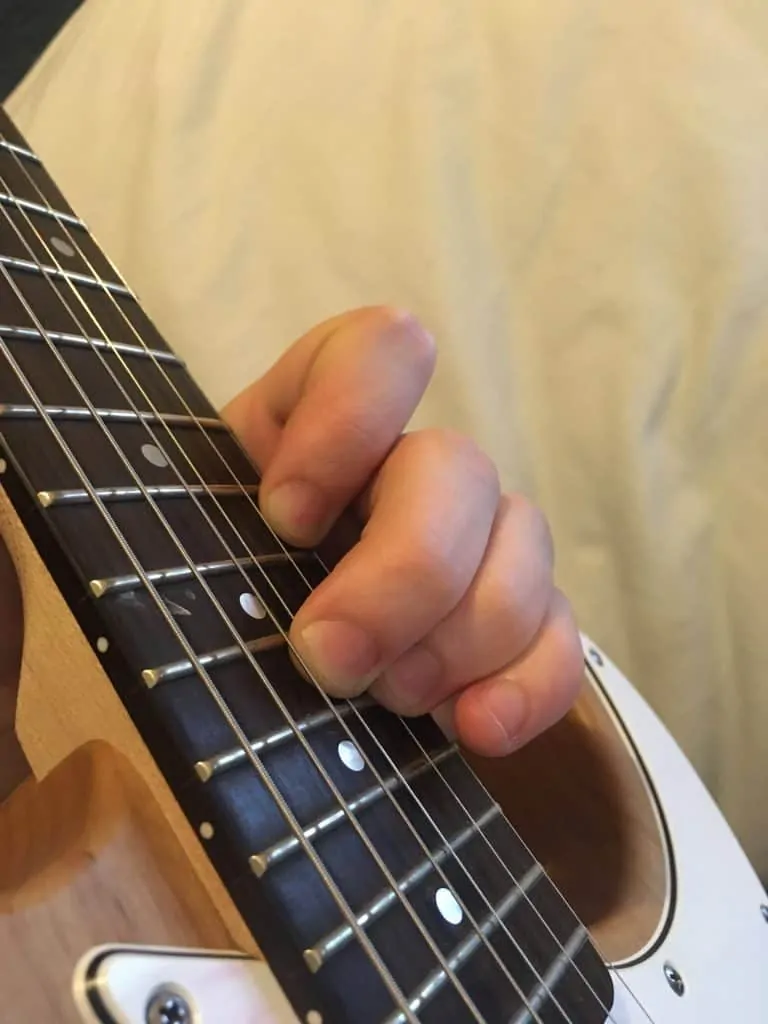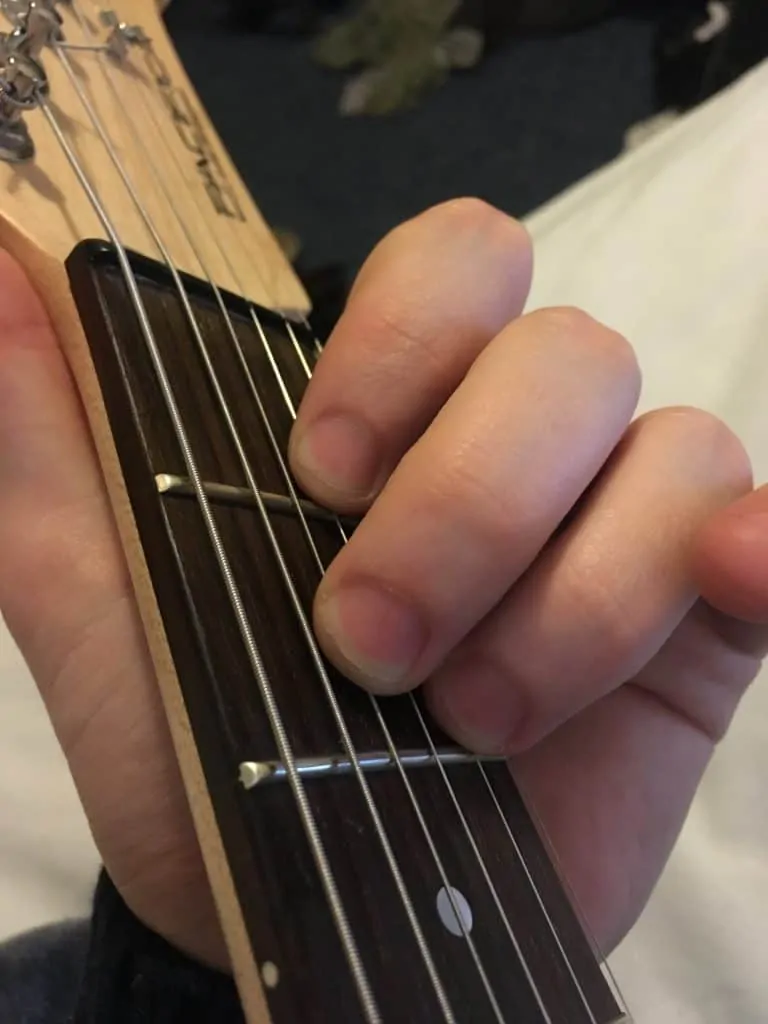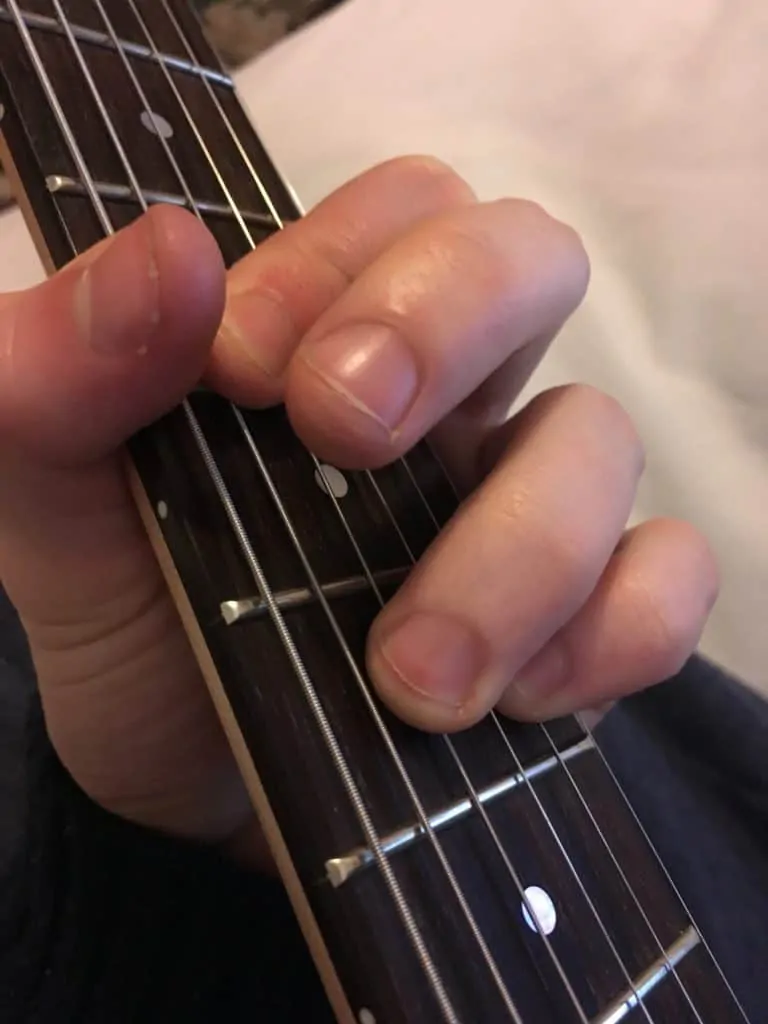Having already looked at ‘open’ chords and their simple shapes, it’s time to move towards some harder to grasp, rarer chords that are known as the ‘black notes’ on a piano.
In this important guide, I’ll be taking you through a huge number of variants of the C#/Db chord:
If you’re looking for a place to start with C#/Db chords, then look no further…
Contents
C#/Db Major Guitar Chord
Every major scale has the same theory behind it, building on a pattern of tones between the notes: 1-1-1/2-1-1-1-1/2. On a piano, the ‘1’ means that if you’re starting on the C, then there will be one note (Db in this case) between your C and the next note of the scale (D), while the 1/2 means that the next note of the scale is directly next door (such as in the move from E-F in C major). On a guitar, the 1/2 means the next fret is in the scale, and the 1 means there will be a fret in between the two notes.
C# major: C#, D#, E#, F#, G#, A#, B#
Db major: Db, Eb, F, Gb, Ab, Bb, C
You may have noticed that we’re looking at two scales here. Sort of… Technically a C# and a Db are exactly the same, they just appear in different contexts. Hence why is you take a look at the scales above, each note is the enharmonic equivalent of each other, so if you played a C# major scale out of context, it would be completely impossible to determine whether it was C# or Db.
For example, in a key with flattened notes, then you’ll (normally) be playing a Db if you need to use that note, but in a key with sharps, then it’ll (normally) be a C#. C# is much more common than Db.
Each of these notes (degrees of the scale) can be assigned a number as it ascends so you can use a helpful formula to work out chords from it. The C# is a 1, the D# is a 2 etc. while for Db major, the Db is a 1, the Eb is a 2 etc.
Once you’re familiar with the scale, you’ll do well to remember that the formula for a C# major chord (and any tonic major chord of any key) is 1-3-5 which gives the notes C#-E#-G#, while the formula for a Db major chord is 1-3-5 which gives the notes Db-F-Ab.
Within the key of C#/Db major, you can make various chord sequences and work them out using this numbering system, but remember that C#/Db major is your tonic, and is where the key will sound resolved and at home.
Songs That Use C#/Db Major Chords
There isn’t much point in choosing to play a C#/Db chord specifically (unless it’s to house a singer’s range etc.) as the actual note isn’t really going to change the sound of the chord, just the pitch. However, the way you play your chord is important and will determine which styles each variation should be used in.
- Ed Sheeran- I See Fire
- The Killers- Mr Brightside
- Rihanna- Umbrella
- Green Day- Jesus Of Suburbia
- Ellie Goulding- Burn
- Fall Out Boy- Thnks fr th Mmrs
- Sia- Chandelier
- Arctic Monkeys- Still Take You Home
- Placebo- This Picture
Playing C#/Db Major
Variation 1
When creating a C#/Db major chord, you’re able to essentially translate the shape of an E major chord up the neck to the 9th fret. If you’re comfortable with barre chords then this one is probably your best option to get a clean, full sound from the chord.
You’ll want to barre the 9th fret using your 2nd finger, then use your 4th to press down on the 11th fret of string 5, your 5th finger to press down on the 11th fret of string 4, and then bring your 2nd finger over to press on the 10th fret of string 3.
Variation 2
This variation of C#/Db major brings you further down the neck, but essentially creates the same sound as version 1, as most of the notes are technically the same and in the same octave. Choosing between the two is mostly a case of personal preference and ease of chord changing, based on what chords you’d been playing up to now/will be playing afterwards.
Barre the 4th fret with your 2nd finger, but be careful to mute your low E string to avoid having it dissonantly ring out below your chord. Then press your 4th across the 6th fret of strings 3 and 4 and your 5th finger on the 6th fret of the 2nd string.
Variation 3
After two barre chords, we need something a bit more simple. While not a totally open chord (as there are no open strings), this is in a simple position low down the neck. Playing acoustic open chords may transition well into this variation.
Make sure you mute your three lowest strings, then press your 2nd finger on the 1st fret of the 3rd string, your 4th finger on the 2nd fret of the 2nd string and your 3rd finger on the 1st fret of the 1st string.
Variation 4
This one will definitely require an electric guitar, because even if your acoustic has this many frets, you’ll be hard pushed to form a chord with them this high up. With such high notes, this variation lends itself really well to playing syncopated funky chords over some thick bass.
Use your 2nd finger to press down on the 16th fret (yeah- that high) of the 1st string, then your 3rd finger on the 18th fret of string 4 and your 4th finger on the 18th fret of string 2.
C#/Db Minor Theory
A minor scale differs slightly from a major scale in that degrees 3, 6 and 7 are all flattened, so they are lowered by one semitone. This creates the C#/Db natural minor scale (variants such as the harmonic and melodic minor will be looked at in a separate guide).
C# minor: C#, D#, E, F#, G#, A, B
Db minor- Db, Eb, Fb, Gb, Ab, Bbb, Cb
We could apply numbers to these much like we did with the major scale, so a minor chord would still be 1-3-5, like the major. But this is a bit confusing, so let’s approach it from the context of the major scale.
A C# minor chord is 1-b3-5, so therefore made up of the notes C#-E-G#, while a Db minor chord is Db-Fb-Ab.
You may have noticed that the Db minor scale has a F and C flats as well as a B double flat. This makes the scale very rare, but the chord of Dbm still appears in many less complex keys.
Songs That Use C#/Db Minor
Again, rarely does a song seek to use the C#/Db note specifically, but rather the minor chord itself. Whether it is as part of the key and therefore makes sense, or to bring out its sadder sound than a major chord, a minor chord is something important throughout all music.
- The Buzzcocks- Ever Fallen In Love
- Dire Straits- Lady Writer
- The Smiths- Big Mouth Strikes Again
- The Cure- Lullaby
- Nicki Minaj- Anaconda
- Train- Drive By
- Avicii- Levels
- Led Zeppelin- No Quarter
- Linkin Park- One Step Closer
- Birdy- Skinny Love
- Ed Sheeran- Shape Of You
- Kanye West- Love Lockdown
- OneRepublic- Counting Stars
C#/Db Minor Guitar Chord
Variation 1
High up the neck, you can create another E-based shape in order to pull off a C#m/Dbm chord, this time it is the minor version you’ll be recreating with a barre underneath.
Barre the 9th fret with your 2nd finger, then press your 4th finger onto the 11th fret of the 5th string and your 5th finger onto the 11th fret of the 4th string. Make sure your barre is pressing the 9th fret of string 3 hard enough for it to be heard.
Variation 2
Now we can use our classic, simple minor chord shape, in this case with the lowest C# root note available to you opening the chord. Personally, this type of minor shape is always my favourite as it can lends itself to so many different styles of playing.
Use your 2nd finger to barre the 4th fret, but make sure to mute the low E string again (though technically this could fit the chord if you’d prefer an E root). Then use your 4th finger to press down the 6th fret of the 4th string, your 5th finger to press the 6th fret of string 3 and your 3rd finger to press down the 5th fret of the 2nd string.
Variation 3
This one gives you another simple, low variety, but in this case, you actually can create its open variety, as the high E string rings out above. This links really well to acoustic music, as you can incorporate it into your open chord playing.
Press your 3rd finger onto the 2nd fret of the 4th string, press your 2nd finger onto the 1st fret of the 3rd string and your 4th finger onto the 2nd fret of the 2nd string, while leaving the high E string open to ring out.
Variation 4
As with the major chords above, there is a nice and easy variation on C#m that you can play really high on the neck of an electric guitar in order to create a funky sound with your playing.
Press your 2nd finger onto the 16th fret of the 1st string, your 3rd finger onto the 17th fret of the 2nd string and your 4th finger on to the 18th fret of the 3rd string.
C#/Db7 Guitar Chord
A C#7/Db7 chord, or C#/Db dominant 7, is a major chord with an added minor 7th. This creates an interval of a tritone within the chord, adding a laying of dissonance to the sound. In a lot of music, the C#7/Db7 is used as part of a perfect cadence, in order to resolve to the tonic. However, one of the primary uses of the dominant 7th in modern music, is as a part of jazzy chord sequences.
If we use major scale theory (which we would unless you’re delving into the realm of modality where this chord has a strong Mixolydian quality) then the formula for this chord is 1-3-5-b7. The b7 takes the B# of a C# major scale down to a regular B, or the Cb of a Db major scale down to a Cbb.
This means that the notes in a C#7 chord are C#-E#-G#-B, while the Db7 chord is made up of the notes Db-F-Ab-Cbb.
Songs That Use C#/Db7
C#7/Db7 chords aren’t overly popular in guitar music, but a lot of easy variations mean they can be used frequently with ease. The use of the dominant 7th gives a distinctive dissonance that allows the chord to be use in poignant parts of slower songs, while fit into jazzy, faster numbers.
- The Beatles- I Will
- Stevie Wonder- I Just Called To Say I Love You
- The Doobie Brothers- What A Fool Believes
Playing C#/Db7
Variation 1
One of the easiest ways to play a C#7/Db7 chord is in the most standard dominant 7th chord shape. This is centred on the 5th string root note and is another good mid-range chord that can be found in loads of styles.
Simply barre the 4th fret using your 2nd finger, muting the low E string, then press your 4th finger down on the 6th fret of string 4, then press your 5th finger down onto the 6th fret of the 2nd string.
Variation 2
This shape is really easy to form and then move up and down the neck in order to provide dominant 7th chords wherever you want. This one lends itself nicely to jazzy playings.
Press down on the 2nd fret of the 2nd string using your 2nd finger, then bring your 3rd finger over to the 3rd fret of the 4th string, then use your 4th finger to press down on the 4th fret of the 5th string and your 5th finger on the 4th fret of the 3rd string.
Variation 3
Lending itself to funk by residing so far up the neck, this shape is a little rarer and a little harder than the ones we’ve approached previously, but it is good for allowing each note to be clearly heard.
Press your 2nd finger onto the 11th fret of the 4th string, then press your 4th finger onto the 13th fret of the 3rd string, your 3rd finger on the 12th fret of the 2nd string and your 5th finger on the 13th fret of the 1st string.
C#/Dbmaj7 Guitar Chord
A C#maj7/Dbmaj7 chord is simply a major chord with a major 7th attached to the top. This often gives it a very uplifting sound, but there is an underlying dissonance due to the major 7th interval.
If we look at it from the point of view of the major scale algorithm, then the chord outlines a pattern of 1-3-5-7.
This means that the notes in an C#maj7 chord are C#-E#-G#-B#, while a Dbmaj7 chord is made up of Db-F-Ab-C.
Songs That Use C#/Dbmaj7
C#maj7 is a good one when used in many contexts due to its ability to slot well into jazz and pop styles. Soul music also finds itself with a lot of maj7 chords chucked in throughout.
- Gus Dapperton- My Favourite Fish
- Tom Misch- So Close
- Explore- Just The Two Of Us
- Jeff Williams- Gold
- Eggstone- Water
Playing C#/Dbmaj7
Variation 1
One of the easiest and most common maj7 shapes you can encounter is probably one you’re probably familiar with thanks to our other guides such as the A chord.
Use your 2nd finger to barre the 4th fret, before pressing your 4th finger onto the 6th fret of the 4th string, your 3rd finger onto the 5th fret of the 3rd string and your 5th finger onto the 6th fret of the 2nd string.
Variation 2
Yet again, we can use a nice high on the neck variation when playing funky chords. However, remember their usage isn’t limited just to this; for example you could fill your guitar with tremolo and be given a nice, wobbling sound when playing chords high on the neck like this.
Place your 2nd finger on the 11th fret of the 4th string, and then use your 4th finger to barre the 13th fret from string 1-3. Make sure you’re able to mute the two lowest strings to avoid having them ring out.
Variation 3
If your grasp of music theory is good, you may have noticed that a Dbmaj7 chord is basically an Fm chord with a Db root note added. This variation basically takes a simple Fm shape and adds this Db root to the low end.
Barre the 1st fret of strings 1, 2 and 3 then reach your 4th finger over to the 3rd fret of the 4th string, and your 5th finger over to the 4th fret of the 5th string. Mute the low E again.
C#/Dbm7 Guitar Chord
The C#m7/Dbm7 chord (C# minor 7) is based on a minor chord with a minor 7th above. It’s sort of the sadder version of the major 7th chord, giving off more of a negative sound due to the minor 3rd, but less dissonance due to the minor 7th interval instead of the major 7th.
If we look at it using the major scale formula, then it follows a pattern of 1-b3-5-b7.
This means that the notes in a C#m7 chord are C#-E-G#-B, while Dbm7 is made up of the notes Db-Fb-Ab-Cb.
Songs That Use C#/Dbm7
Similarly to C#maj7/Dbmaj7, C#m7/Dbm7 can fit nicely into a lot of jazz music due its 7th interval, but equally it appears a lot in popular music styles as despite its dissonance, it has a pleasant tone.
- Usher- Something Special
- Ne-Yo- Back To What You Know
- Michael Bublé- Everything
- Toto- Africa
- Donald Fagen- Snowbound
Playing C#/Dbm7
Variation 1
Like with the C#maj7 above, there is a distinctly simple variation of this chord type that you can move up and down the neck with ease, and that lends itself to a variety of styles.
Barre the 4th fret using your 2nd finger, then use your 4th finger to press the 6th fret of the 4th string, and your 3rd finger to press down on the 5th fret of the 2nd string. In this case, you’re going to want to mute both the high and low E strings.
Variation 2
This barre version is arguably the easiest way of playing a C#m7, but due to its centrality on the lowest string, I feel it sounds a bit blurred; but if you’re just getting used to barre chords then it is a good one to get started with.
Barre the entire 9th fret using your 2nd finger, then press down on the 11th fret of the 5th string using your 4th finger. Simple as that!
Variation 3
This is a strange voicing of the chord, as it includes two open strings despite not being particularly low on the neck. Because of this, a wishy washy, almost dreamy sound can be created in its usage, especially because you could move the shape up and down the neck while maintaining the drone like open strings.
Press your 2nd finger down onto the 4th fret of the 5th string, then your 4th finger on the 6th fret of the 4th string and your 5th finger on the 6th fret of the 3rd string. Leave the 1st and 2nd strings open to ring out. s
Other C#/Db Guitar Chords
There are a lot of other types of chords you can use based around your C#/Db tonic. The ones I’ve shown you so far are probably the most common you’ll come across, particularly major and minor.
- C#b5 is a major chord, with the G# 5th being flattened and creating a dissonant tritone. The formula is 1-3-b5 so the notes are C#-E-G.
- C#m11 is a minor 7th chord that adds an 11th. This is essentially a 4th, but due to the avoidance of minor 2nd’s it isn’t too dissonant. The formula is 1-b3-5-b7-11 and the notes C#-E-G#-B-F#
- Dbmaj7b13 is interesting, as the 13th (essentially the 6th raised by an octave) is flattened, creating an unexpected dissonance. This makes the formula 1-3-5-7-b13 and the notes Db-F-Ab-C-Bbb.
There are obviously a lot more chords than this, but these are a few I really like. I have a few tricks to bear in mind when working out chords yourself.
- If you’re in an alternate tuning, remember these explanations won’t be the same!
- Using a formula to work out what notes are in a chord is a really simple way to help you out.
- When building chords that are hard to voice, the 5th is the first degree of the chord you are able to drop. Never drop the root, because that will normally completely change the chord you’re playing. For example, dropping the C# from a C#m7 chord just makes E major…
Good Luck!

Cheanné Lombard lives in the home of one of the new Seven World Wonders, Cape Town, South Africa. She can’t go a day without listening to or making music.
Her love of music started when her grandparents gave her a guitar. It was a smaller version of the full-sized guitars fit for her little hands. Later came a keyboard and a few years after that, a beautiful dreadnought guitar and a violin too. While she is self-taught when it comes to the guitar, she had piano lessons as a child and is now taking violin lessons as an adult.
She has been playing guitar for over 15 years and enjoys a good jam session with her husband, also an avid guitarist. In fact, the way he played those jazzy, bluesy numbers that kindled the fire in her punk rock heart. Now she explores a variety of genres and plays in the church worship group too and with whoever else is up for a jam session.
















